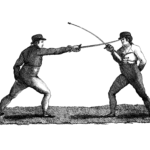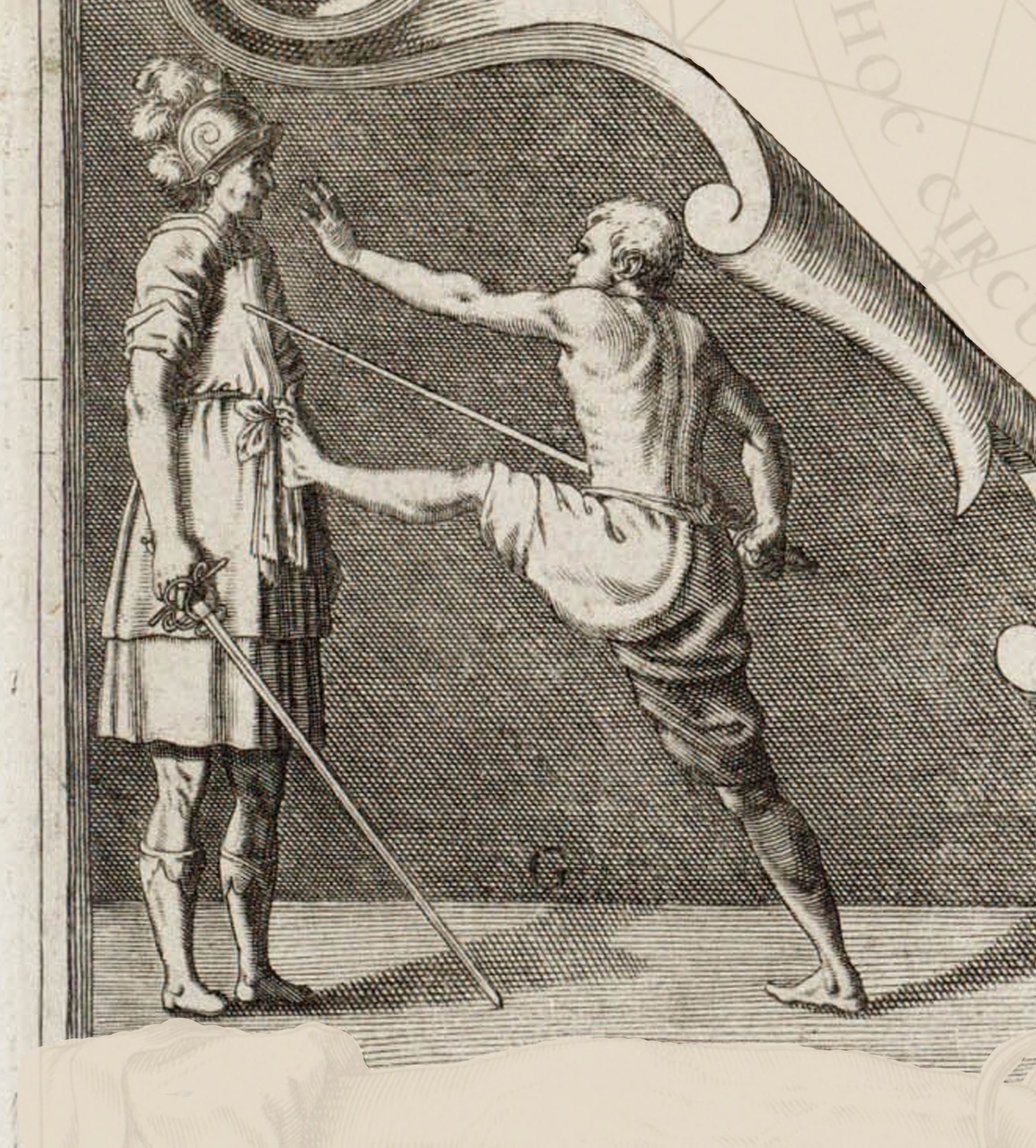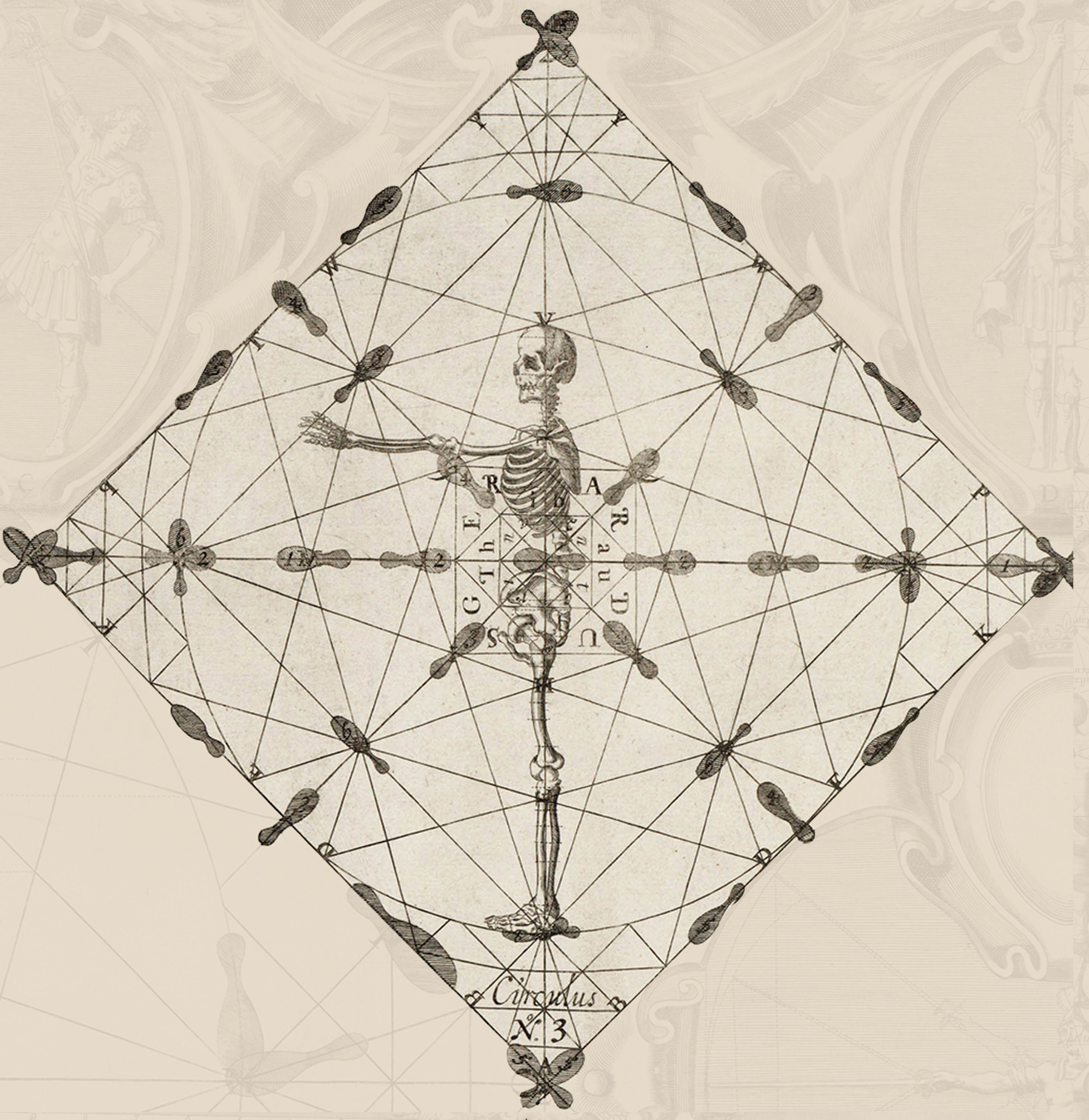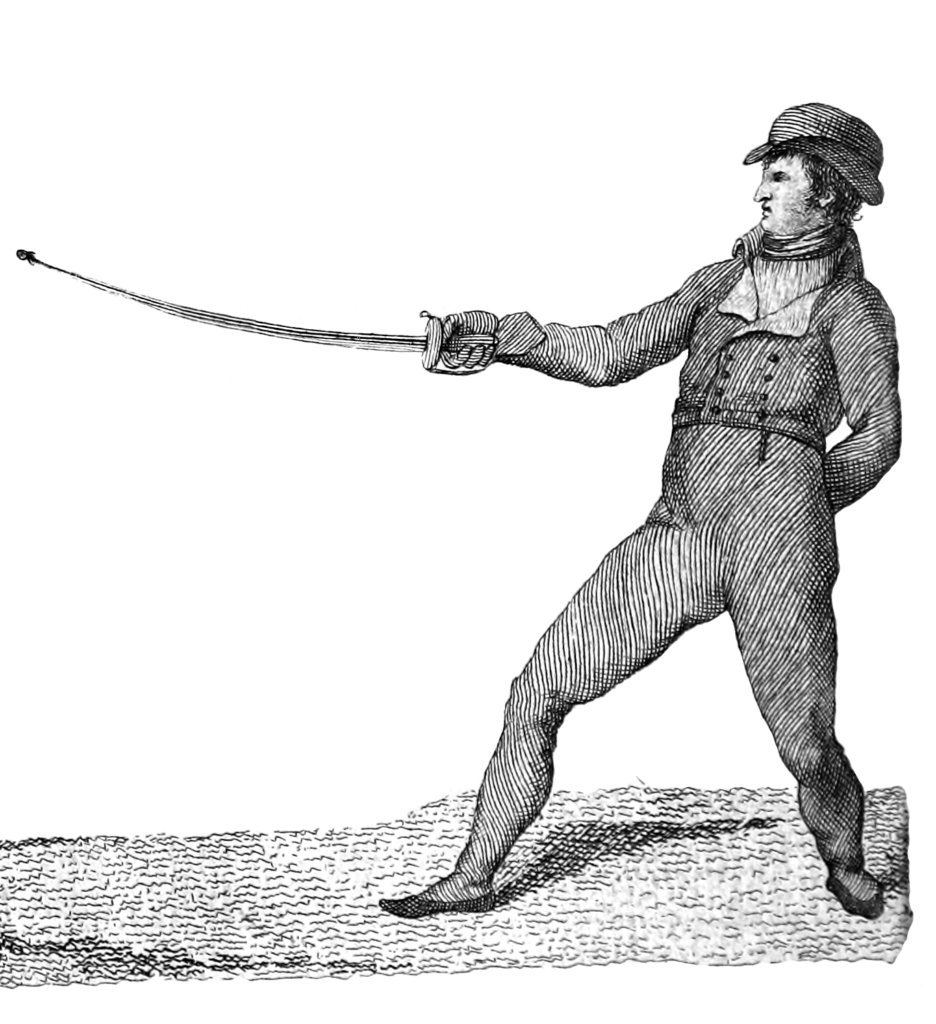134. This chapter, and those which remain of this fourth part, is nothing but an ordered collection of all the shots and parries that can be made with the sabre. I recently advertised the points that are uncovered in each of the removals of the first order, where you can target the enemy with a second offense. But since, without attacking these points, we cannot present those which are uncovered in second order removals, it is necessary before teaching these to know how to attack them according to the best rules of battle. It is not, therefore, outside of our purpose to have passed to this fourth part when it could be believed that the third has not yet been completed. And so, I will continue in this one enumerating the points which are provided in the subsequent removals.
Thrust of Third on the Parry of Fourth, and its Removal

135. If the enemy repaired with fourth the attack that was thrown on his guard of third, (§§ 88 and 91), balance a little back without resetting and free below his sabre at the same time. Turn your hand fully into third without lowering it from the superior plane to infer a thrust of third on the arm, balancing forward to take the reach again, moving from square and executing the wound, recovering immediately to the defensive measure (Plate 6, Figure 11, Letter C).

136. To remove this thrust, it is necessary that, at the same time the contrary frees the point of his weapon to wound, you turn your hand into the half third position and bend your arm to join the elbow to your right vertical, taking the point of your sabre to the place indicated for the removal of low third (§ 129), this being necessary for the reparation of this wound, in consideration of the general rule of removing the strong on the weak (Plate 6, Figure 11, Letter D).
Points which are Uncovered in Low Third
137. Bearing in mind that this removal is low and with an open point, as its very nature required, according to the general rule of removals, it uncovers all of the points to which the repetition of another wound formed by the point of the enemy’s sabre can be directed, as they are: the half reverse, vertical cut, and all of the diagonals to the left side. From below the guard can be formed the thrust of second between the weapons, thrust of fourth, reverse to the thigh, or diagonal from the right rump to the opposite shoulder.
Counter-Edge Blow to the Wrist on a Parry of Fourth, and its Removal

138. When the opponent waits, affirmed in third, attack with the free thrust of fourth but, instead of accompanying it with a deep step, make only a balance forward, giving at the same time a strike with the sole of the right foot on the ground, without increasing the step, to obligate the contrary to do a removal of fourth. And, in the time they do it, lower the point of the sabre a little, place the counter-edge underneath the removing wrist and, giving all possible upward impulse, cut his hand, if the proposed idea was to only strike with the counter-edge, but if the purpose was to gain the thrust and the enemy repaired it (§§ 88 and 91) you can, in consequence of its removal, respond by executing this same blow (Plate 6, Figure 10, Letter A).
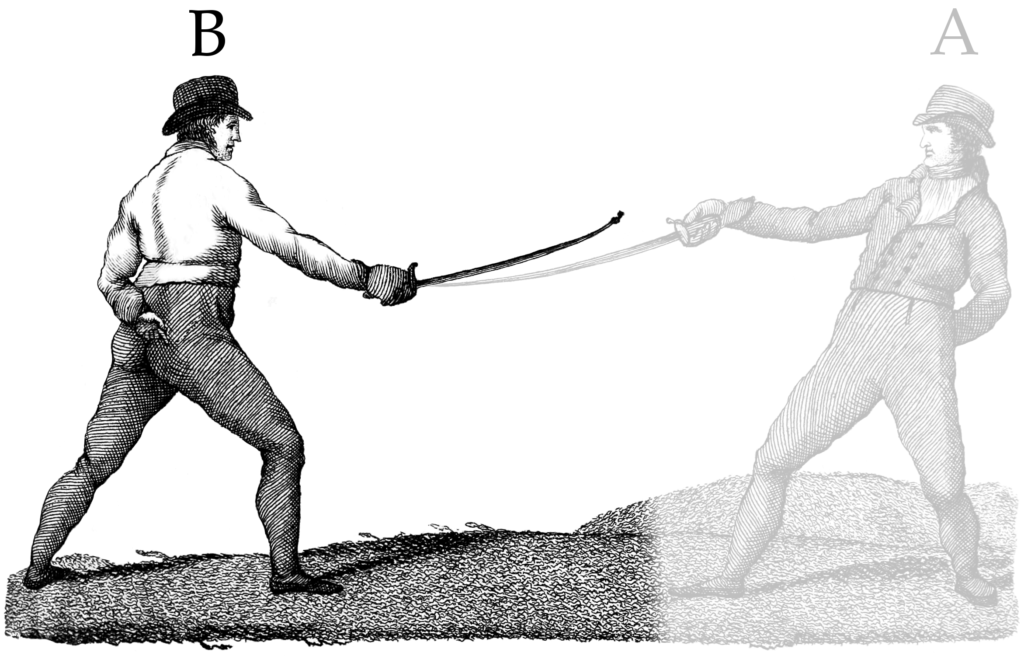
139. Remove this wound with low fourth (§ 128), with the difference that the elbow will separate from the body and the arm will open on the right vertical enough for the guard to be lined up with it, and the sabre will travel between the bodies and point outside the enemy’s right shoulder with the strong of the blade coming to occupy the place that the wrist previously had. I call this the removal of low fourth with the extended arm because it a variation of the regular low fourth (Plate 6, Figure 10, Letter B).
Points Which are Uncovered in Low Fourth
140. On this removal are uncovered that I have advertised in the regular parry of fourth.
Notice
141. The two previous battles, and those that follow in this chapter, are all formed when the contrary waits in third, so that throwing a thrust in fourth, a movement of profile is required to uncover the points necessary to attack as a second offense on the removal of fourth that would go to the thrust. I propose to follow the order lent the points that are uncovered in each removal in paragraph 39. I have decided to start with these, and so I will omit repeating the guard of third in every battle, satisfied that this warning will not be thrown into oblivion, so little as to never start any battle from the defensive measure be it of one, two, or more shots, with a cut but with a thrust.
Half Cut to the Thigh on the Parry of Fourth and its Removal

142. The enemy, having repaired with fourth the thrust that we attempted to throw from the guard of third, throw your arm downward a little and turn your hand into the position of half-fourth, to replace with the greatest violence by executing a horizontal or diagonal half cut to the right thigh on the inside, with only a separation from the contrary weapon and lowering your own to the point of the wound. Note that the knee will be thrown more immediately as shown in Plate 7, Figure 12, Letter A, and less in the opposite, Letter B.

143. To remove this blow with your sabre, it would be necessary to take the removal of first, but, since a very large movement would be done for this parry, and the wound consists of a very short one, the defense is impossible. But nature, always attentive to our conservation has multiplied the methods by which we may seize the skill in a timely manner. One of these consists of the movements of the body and it is the timely one to choose in this present case. To defend against this wound, it is not necessary to do anything other than to remove the reach of the enemy’s sabre by means of straightening the leg as if you were trying to put yourself in the right stance, retiring the foot one place on the line. Balancing the trunk (or the upper half of the body) forward, and giving the arm its full extension, execute at the same time a thrust to the source of the right of your contrary, as seen in Figure 13, of Pate 7, Letter C. Not only will you have avoided the attempted attack, but inflicting another unto your enemy at the same time, you will happily conclude your battle. But, the utmost attention to the hand of your opponent is necessary for this, for, if the tempo of this movement is lost, everything is useless, and the wound inevitable.
Vertical Cut to the Arm on the Parry of Fourth and its Removal
144. If the enemy escapes the thrust to the inside, forming the removal of fourth, balance back, turn your hand fully into third position, and from here, by freeing the point to the outside, execute above the wrist a cut with greatest speed, replacing it so immediately that one movement can hardly be distinguished from another.
145. To remove this blow, turn to the removal of third of the first order for, even if it is carried out after a deep step of the contrary, the balance to the rear in its execution decreases the reach and, consequently, the removal of the second order is not necessary. The points that are uncovered in this removal are advertised in paragraph 96.
Half Reverse to the Face on the Parry of Fourth, and its Removal
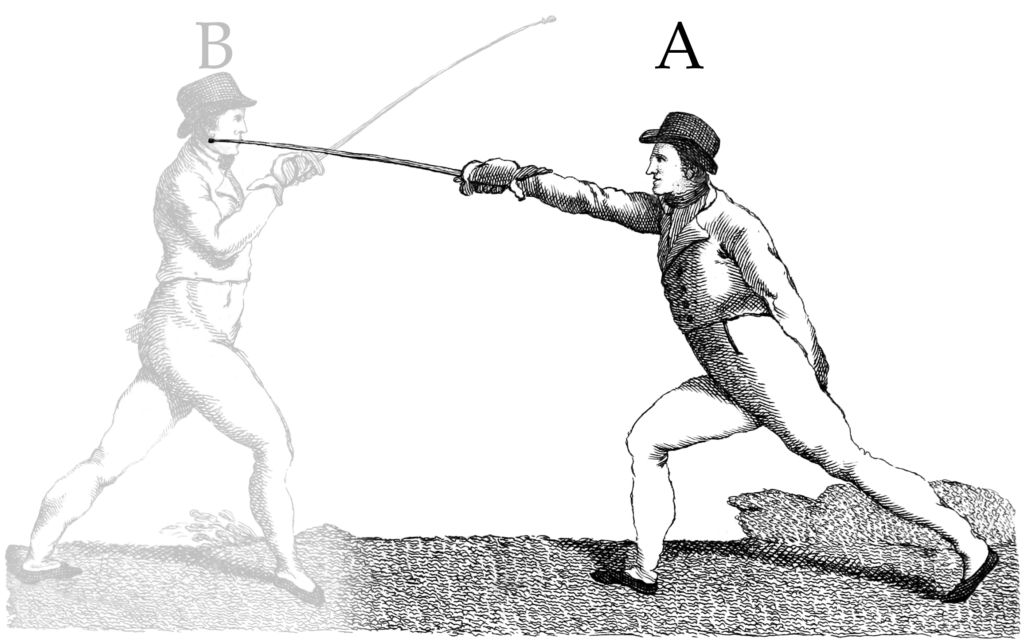
146. The enemy having repaired with fourth the thrust of third, turn the hand fully into third position, raising the elbow to the height of the supreme plane and free the sabre below the contrary’s guard, making it walk up close to the left shoulder, balancing back at the same time, and turning to balance forward, moving square, execute a half reverse to the face with the necessary opposition, recovering to your stance without loss of time (Plate 8, Figure 14, Letter A).

147. Remove this blow with a parry of high third, but, by virtue of the enemy having chosen to direct the offense from the offensive measure, it is necessary to join the elbow to the right vertical and put the guard forward and at the height of the shoulder on this side, and the point higher than the supreme plane in line with the stated vertical, so that the strong is opposed to the intended blow, not forgetting the motion to square (Plate 8, Letter B). This removal is a variation of high third which I will call a collection in high third. The points which are uncovered in this removal are the half reverses to the arm, thigh, and belly, if you can do this, or the diagonal or horizontal from the haunch to the shoulder, and thrust of second, all from below the guard, to distinguish from the vertical or diagonal to the face or any other point of the left vertical which are formed by the point.
Vertical Cut to the Head on the Parry of Fourth and its Removal
148. After the enemy has repaired the thrust thrown with the removal of fourth, free from below the guard in the manner stated in the previous attack, without omitting the balance, opposition, etc, executing a vertical cut to the head or shoulders, moving in half position, resetting your guard and stance immediately. Note that in the same manner, and under the same circumstances, you can throw a diagonal cut to the face.

149. This last blow, with respect to the first, does not admit a noticeable difference in their formation and execution. Consequently, a single removal will cover each and every one of them. The parry of high third is the most immediate and secure in this case (Plate 8, Figure 14, Letter B). For this reason, and having no difference, I refer the reader to paragraph 131 where the removals of the second order are treated to give the necessary explanation. The points that are uncovered on this remove are stated in paragraph 147.


